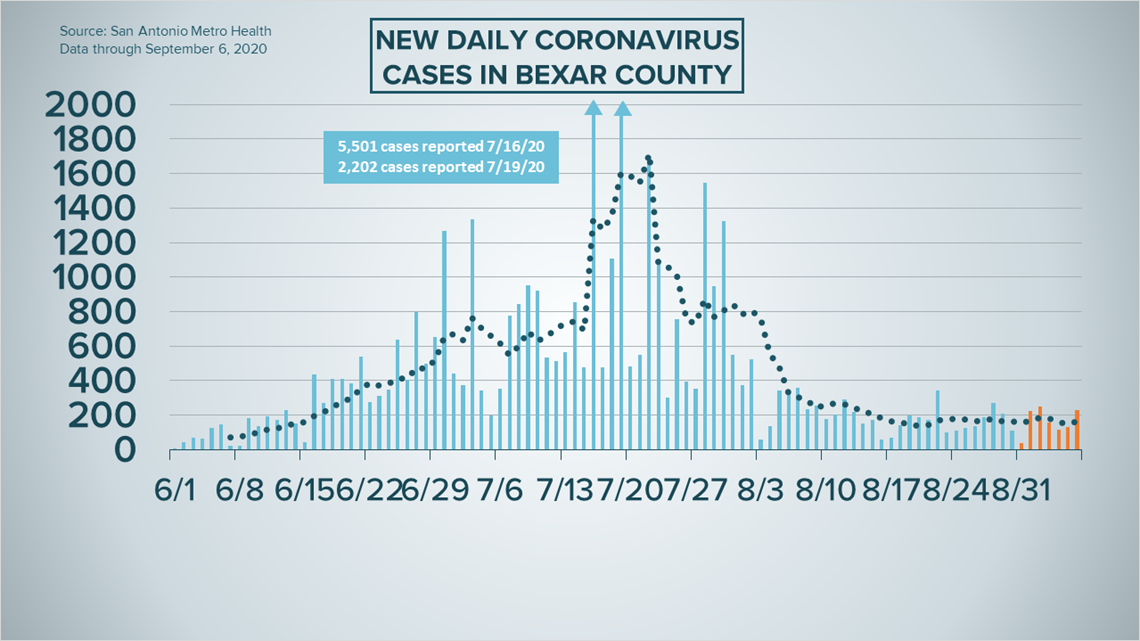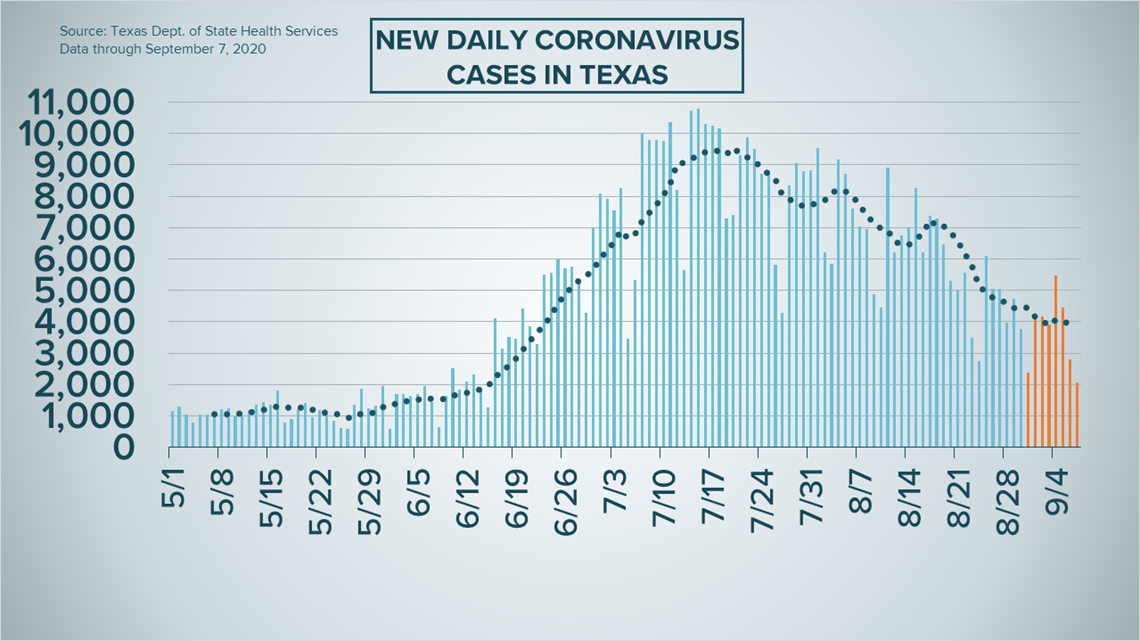SAN ANTONIO — We're tracking the latest numbers from the coronavirus pandemic in San Antonio and across Texas. Here are the latest numbers reported by Bexar and surrounding counties:
- Bexar County: 228 new cases were reported Sunday, bringing the total number for the county to 47,543. The county death toll, meanwhile, rose to 978 after six new fatalities were reported and an additional 49 deaths between April and August were confirmed to be coronavirus.
- Comal County: The county reported 21 additional cases and no additional deaths Friday, the last time new numbers were offered. There have been a total of 3,071 cases of COVID-19 in the county – including 2,440 confirmed cases – while 111 county residents have died. County officials say there are 288 active coronavirus cases, and 2,672 residents are considered recovered.
- Hays County: Officials in Hays County on Friday reported 25 new cases in the county and no additional virus-related deaths. As of Friday, there are a total of 5,471 lab-confirmed cases in the county (1,987 of which are active) while the death toll remains at 50. 3,434 are considered recovered. Hays County officials will not report further numbers until Tuesday, September 8 due to the Labor Day holiday. That report will include data from Saturday, Sunday, and Monday.
How Bexar County is trending
We've tracked how many coronavirus cases have been confirmed in Bexar County from the time officials began reporting cases in March 2020. The graphic below shows the number of cases since June and charts those daily case numbers along a 7-day moving average to provide a more accurate picture of the overall coronavirus case curve in our area and the direction we're trending amid the pandemic.
San Antonio Metro Health did not report any new numbers on Monday, observing Labor Day.
On Sunday, Metro Health updates its online coronavirus dashboards to report 228 new coronavirus cases in Bexar County. That brings the total to 47,543 since the pandemic began.


Metro Health also reported six new virus-related deaths on Sunday; and 49 additional deaths between April 14 and August 18. In all, Metro Health has confirmed 978 deaths from virus-related complications. On Saturday that number was 893, and the reason for the discrepancy in the numbers is unclear.
On Friday, Metro Health announced the office would separate current cases and deaths from backlogged cases and deaths older than 14 days, following guidance from the Texas Department of State Health Services.
Local officials will report backlogged cases and deaths every Sunday at 7 p.m. and will also report demographic data of those backlogs. Current new cases and deaths will continue to be reported on a daily basis.
181 deaths are under investigation, as DSHS has reported 1,159.
Hospitalizations, however, continue to drop for the county. On Sunday, Bexar County reported 306 hospitalized for COVID-19. The number of patients in intensive care (141) fell by four while the number of patients using ventilators (83) increased by two.
Coronavirus in Texas
The Texas Department of State Health Services on Monday reported an additional 2,057 cases of the novel coronavirus across the state. State officials say three "older cases" were included in the statewide total but excluded from its confirmed case totals. More information can be found at the top of this page.


As of Monday, at least 640,370 Texans have been infected with COVID-19.
Meanwhile, the state also reported an additional 20 coronavirus-related deaths on Monday, raising the death toll to 13,472.
More than 543,000 Texans have recovered from the coronavirus, while an estimated 81,426 cases remain active.
The number of patients currently in Texas hospitals dropped to 3,537 on Monday, the lowest number since June 21.
On Monday, Governor Greg Abbott extended the disaster declaration for all Texas counties in response to coronavirus. The proclamation was first issued on March 13.
"I urge Texans to take precautionary steps to protect their health by wearing a mask, social distancing, and sanitizing their hands. Working together, we will slow the spread and keep our communities safe," said Gov. Abbott.
As the school year begins to get underway for local districts, we are also keeping track of the most important updates for each, including links to dashboards created to track coronavirus cases.
Latest Coronavirus Headlines
- Here's how colleges put small towns at greater risk for COVID-19
- Historic Gruene Hall reopens with live music and coronavirus precautions
- Hopes fading for coronavirus deal as Congress returns
- Boerne City Hall scaling down operations after public-facing employee tests positive for coronavirus
- Colleges combating coronavirus turn to stinky savior: sewage
- NFL won't test for COVID-19 on game days, but will every other day
Coronavirus symptoms
The symptoms of coronavirus can be similar to the flu or a bad cold. Symptoms include fever or chills, cough, shortness of breath or difficulty breathing, fatigue, muscle or body aches, headache, new loss of taste or smell sore throat, congestion or runny nose, nausea or vomiting and diarrhea, according to the Centers for Disease Control.
Most healthy people will have mild symptoms. A study of more than 72,000 patients by the Centers for Disease Control in China showed 80 percent of the cases there were mild.
But infections can cause pneumonia, severe acute respiratory syndrome, kidney failure, and even death, according to the World Health Organization. Older people with underlying health conditions are most at risk.
On June 25, the CDC expanded the list of groups at a higher risk of severe illness due to coronavirus.
Experts determined there was consistent evidence these conditions increase a person's risk, regardless of age:
- Chronic kidney disease
- COPD (chronic obstructive pulmonary disease)
- Obesity (BMI of 30 or higher)
- Immunocompromised state (weakened immune system) from solid organ transplant
- Serious heart conditions, such as heart failure, coronary artery disease, or cardiomyopathies
- Sickle cell disease
- Type 2 diabetes
The CDC believes symptoms may appear anywhere from two to 14 days after being exposed.
Human coronaviruses are usually spread...
- Between people who are in close contact with one another (within about 6 feet).
- Through respiratory droplets produced when an infected person coughs, sneezes or talks. These droplets can land in the mouths or noses of people who are nearby or possibly be inhaled into the lungs.
- Some recent studies have suggested that COVID-19 may be spread by people who are not showing symptoms.
Help stop the spread of coronavirus
- Stay home when you are sick.
- Eat and sleep separately from your family members
- Use different utensils and dishes
- Cover your cough or sneeze with your arm, not your hand.
- If you use a tissue, throw it in the trash.

